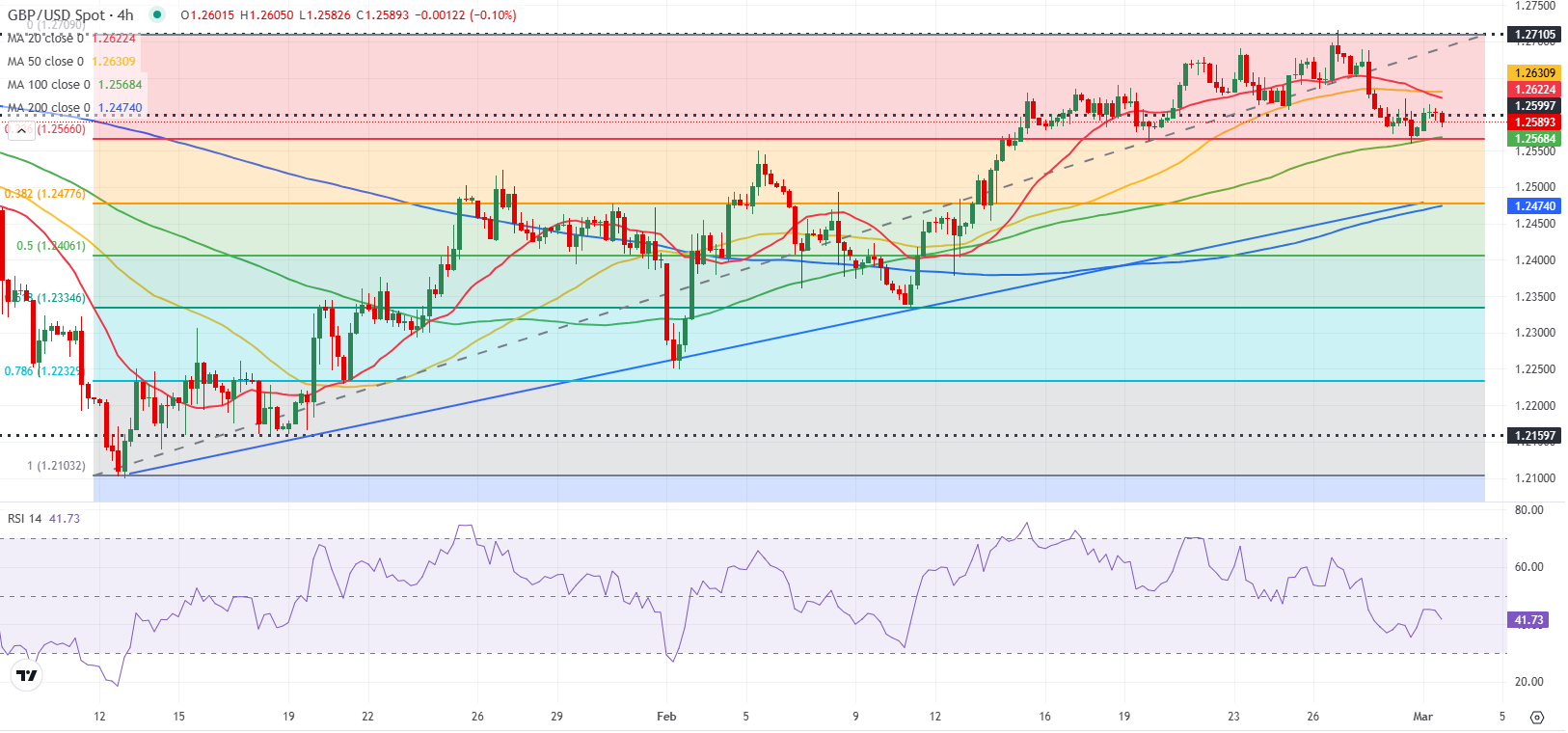- GBP/USD stays in positive territory near 1.2600 on Monday.
- The risk-averse market atmosphere could cap the pair's upside.
- February ISM Manufacturing PMI will be featured in the US economic calendar.
GBP/USD registered daily losses on Thursday and Friday to end the previous week in negative territory. The pair holds steady at around 1.2600 in the European morning on Monday.
British Pound PRICE Last 7 days
The table below shows the percentage change of British Pound (GBP) against listed major currencies last 7 days. British Pound was the weakest against the US Dollar.
| USD | EUR | GBP | JPY | CAD | AUD | NZD | CHF | |
|---|---|---|---|---|---|---|---|---|
| USD | 0.65% | 0.34% | 0.63% | 1.52% | 2.25% | 2.50% | 0.40% | |
| EUR | -0.65% | -0.40% | -0.17% | 0.67% | 1.58% | 1.64% | -0.42% | |
| GBP | -0.34% | 0.40% | 0.28% | 1.08% | 1.99% | 2.05% | -0.03% | |
| JPY | -0.63% | 0.17% | -0.28% | 0.88% | 1.69% | 1.93% | -0.14% | |
| CAD | -1.52% | -0.67% | -1.08% | -0.88% | 0.67% | 0.96% | -1.09% | |
| AUD | -2.25% | -1.58% | -1.99% | -1.69% | -0.67% | 0.06% | -1.96% | |
| NZD | -2.50% | -1.64% | -2.05% | -1.93% | -0.96% | -0.06% | -2.03% | |
| CHF | -0.40% | 0.42% | 0.03% | 0.14% | 1.09% | 1.96% | 2.03% |
The heat map shows percentage changes of major currencies against each other. The base currency is picked from the left column, while the quote currency is picked from the top row. For example, if you pick the British Pound from the left column and move along the horizontal line to the US Dollar, the percentage change displayed in the box will represent GBP (base)/USD (quote).
The broad-based US Dollar (USD) strength in the second half of last week caused GPB/USD to stretch lower. US President Donald Trump's confirmation of March 4th as the date for 25% tariffs on Canadian and Mexican imports, as well as an additional 10% tariff on Chinese goods, to go into effect, combined with his argument with Ukrainian President Volodymyr Zelenskyy in the Oval Office on Friday forced investors to stay away from risk-sensitive assets heading into the weekend.
Later in the American session, February ISM Manufacturing Purchasing Managers Index (PMI) data will be featured in the US economic calendar. In case the headline PMI unexpectedly drops below 50 and shows contraction in the manufacturing sector's business activity, the immediate reaction could hurt the USD and support GBP/USD.
Investors will also pay close attention to changes in the risk perception. At the time of press, US stock index futures were down between 0.1% and 0.2%. In case safe-haven flows dominate the action in financial markets after Wall Street's opening bell, GBP/USD could come under renewed bearish pressure.
On the other hand, the market mood could improve and open the door for an extended recovery in GBP/USD if the Trump administration decides to postpone March 4 tariffs.
GBP/USD Technical Analysis
GBP/USD failed to make a daily close above the 100-day Simple Moving Average (SMA), currently located at 1.2650, after rising above this level on Friday. Additionally, the Relative Strength Index (RSI) indicator on the 4-hour chart stays near 40, reflecting a lack of buyer interest.
On the downside, 1.2560 (100-period SMA, Fibonacci 23.6% retracement of the latest uptrend) aligns as first support before 1.2500 (round level, static level) and 1.2475 (200-period SMA, Fibonacci 38.2% retracement). Looking north, first resistance could be spotted at 1.2600 (static level, round level) ahead of 1.2650 (100-day SMA) and 1.2700-1.2710 (round level, static level).
Pound Sterling FAQs
The Pound Sterling (GBP) is the oldest currency in the world (886 AD) and the official currency of the United Kingdom. It is the fourth most traded unit for foreign exchange (FX) in the world, accounting for 12% of all transactions, averaging $630 billion a day, according to 2022 data. Its key trading pairs are GBP/USD, also known as ‘Cable’, which accounts for 11% of FX, GBP/JPY, or the ‘Dragon’ as it is known by traders (3%), and EUR/GBP (2%). The Pound Sterling is issued by the Bank of England (BoE).
The single most important factor influencing the value of the Pound Sterling is monetary policy decided by the Bank of England. The BoE bases its decisions on whether it has achieved its primary goal of “price stability” – a steady inflation rate of around 2%. Its primary tool for achieving this is the adjustment of interest rates. When inflation is too high, the BoE will try to rein it in by raising interest rates, making it more expensive for people and businesses to access credit. This is generally positive for GBP, as higher interest rates make the UK a more attractive place for global investors to park their money. When inflation falls too low it is a sign economic growth is slowing. In this scenario, the BoE will consider lowering interest rates to cheapen credit so businesses will borrow more to invest in growth-generating projects.
Data releases gauge the health of the economy and can impact the value of the Pound Sterling. Indicators such as GDP, Manufacturing and Services PMIs, and employment can all influence the direction of the GBP. A strong economy is good for Sterling. Not only does it attract more foreign investment but it may encourage the BoE to put up interest rates, which will directly strengthen GBP. Otherwise, if economic data is weak, the Pound Sterling is likely to fall.
Another significant data release for the Pound Sterling is the Trade Balance. This indicator measures the difference between what a country earns from its exports and what it spends on imports over a given period. If a country produces highly sought-after exports, its currency will benefit purely from the extra demand created from foreign buyers seeking to purchase these goods. Therefore, a positive net Trade Balance strengthens a currency and vice versa for a negative balance.
Information on these pages contains forward-looking statements that involve risks and uncertainties. Markets and instruments profiled on this page are for informational purposes only and should not in any way come across as a recommendation to buy or sell in these assets. You should do your own thorough research before making any investment decisions. FXStreet does not in any way guarantee that this information is free from mistakes, errors, or material misstatements. It also does not guarantee that this information is of a timely nature. Investing in Open Markets involves a great deal of risk, including the loss of all or a portion of your investment, as well as emotional distress. All risks, losses and costs associated with investing, including total loss of principal, are your responsibility. The views and opinions expressed in this article are those of the authors and do not necessarily reflect the official policy or position of FXStreet nor its advertisers. The author will not be held responsible for information that is found at the end of links posted on this page.
If not otherwise explicitly mentioned in the body of the article, at the time of writing, the author has no position in any stock mentioned in this article and no business relationship with any company mentioned. The author has not received compensation for writing this article, other than from FXStreet.
FXStreet and the author do not provide personalized recommendations. The author makes no representations as to the accuracy, completeness, or suitability of this information. FXStreet and the author will not be liable for any errors, omissions or any losses, injuries or damages arising from this information and its display or use. Errors and omissions excepted.
The author and FXStreet are not registered investment advisors and nothing in this article is intended to be investment advice.
Recommended Content
Editors’ Picks

Gold falls amid a possible de-escalation of US-China tensions Premium
Gold pulled back from its all-time high of $3,500 per troy ounce reached earlier on Tuesday, as a resurgent US Dollar and signs of easing tensions in the US–China trade dispute appeared to draw sellers back into the market.

EUR/USD retreats to daily lows near 1.1440
EUR/USD loses the grip and retreats to the 1.1440 zone as the Greenback’s rebound now gathers extra steam, particulalry after some positive headlines pointing to mitigating trade concerns on the US-China front on Tuesday.

GBP/USD deflates to weekly lows near 1.3350
GBP/USD loses further momentum and recedes to the 1.3350 zone on Tuesday, or two-day troughs, all in response to the frmer tone in the US Dollar and encouraging news from the US-China trade scenario.

3% of Bitcoin supply in control of firms with BTC on balance sheets: The good, bad and ugly
Bitcoin disappointed traders with lackluster performance in 2025, hitting the $100,000 milestone and consolidating under the milestone thereafter. Bitcoin rallied past $88,000 early on Monday, the dominant token eyes the $90,000 level.

Five fundamentals for the week: Traders confront the trade war, important surveys, key Fed speech Premium
Will the US strike a trade deal with Japan? That would be positive progress. However, recent developments are not that positive, and there's only one certainty: headlines will dominate markets. Fresh US economic data is also of interest.

The Best brokers to trade EUR/USD
SPONSORED Discover the top brokers for trading EUR/USD in 2025. Our list features brokers with competitive spreads, fast execution, and powerful platforms. Whether you're a beginner or an expert, find the right partner to navigate the dynamic Forex market.
